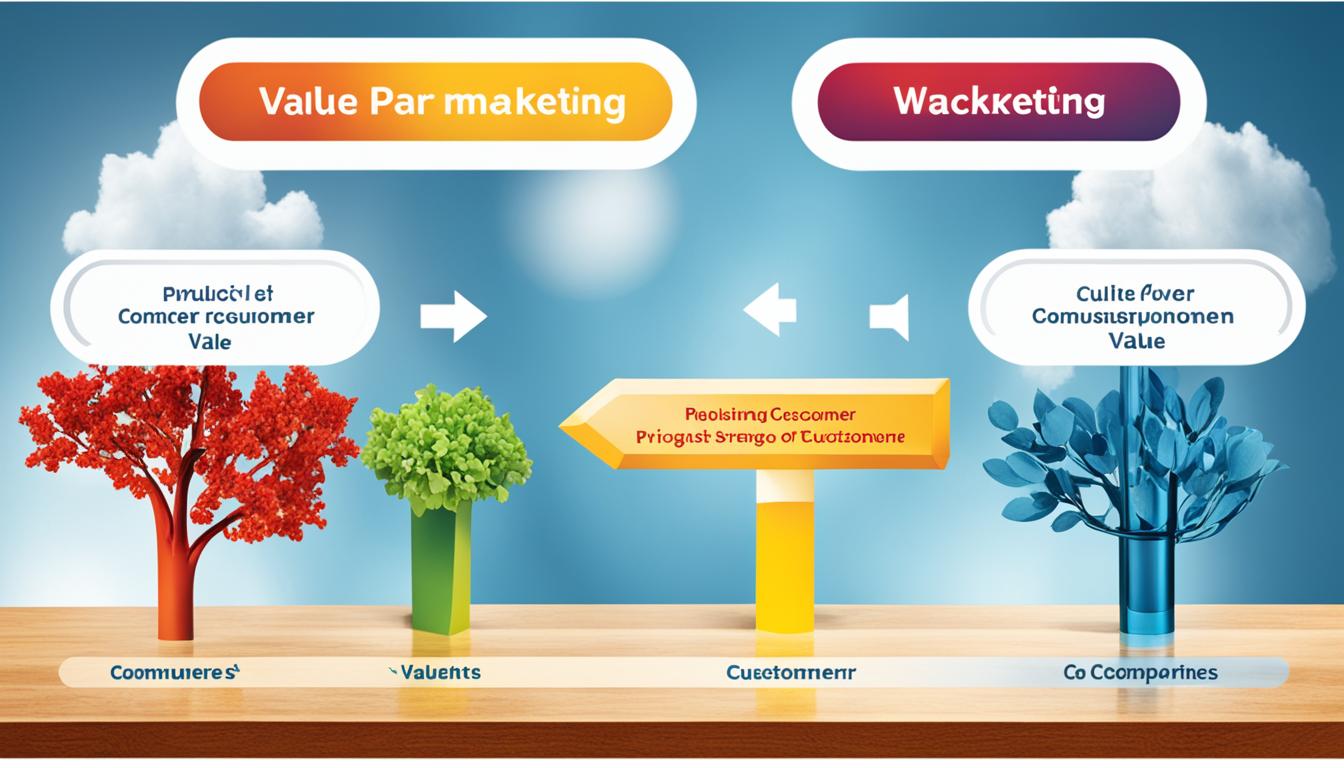Bootstrap marketing is a cost-effective strategy for promoting a business with a limited budget. In today’s digital age, small businesses can leverage various online marketing techniques to reach their target audience and drive sales. From SEO optimization to social media marketing and content creation, bootstrap marketing offers a range of strategies that can propel business growth without breaking the bank.
In this article, we will explore different examples of bootstrap marketing strategies that small businesses can implement to maximize their online presence and attract customers. Whether you’re a startup or an established business, these techniques can help you optimize your website, increase brand visibility, and connect with your target market.
Key Takeaways:
- Bootstrap marketing is a cost-effective strategy for small businesses with a limited budget.
- Digital marketing techniques such as SEO, social media marketing, and content creation can drive business growth.
- Optimizing your website through on-site and off-site SEO techniques can improve online visibility.
- Social media platforms provide an opportunity to engage with your target audience and promote your products or services.
- Creating valuable and relevant content can help build brand loyalty and attract new customers.
Email Marketing: Building Customer Relationships
Email marketing is a powerful tool for building strong customer relationships and enhancing brand recognition. With its cost-effectiveness and wide reach, it allows small businesses to stay in touch with their target audience and promote their products and services.
One of the key aspects of email marketing is building an email list of interested subscribers. Small businesses can encourage sign-ups by offering valuable incentives such as free downloads, special offers, and exclusive tips. By providing value from the start, businesses can establish a solid foundation for a positive customer relationship.
Once the email list is established, small businesses can send targeted messages to their subscribers. These messages can be customized based on the individual interests and preferences of the recipients, making them more personalized and relevant. By delivering tailored content, businesses can strengthen their connection with customers and increase the effectiveness of their marketing campaigns.
However, it’s important to ensure that subscribers have the option to unsubscribe easily if they no longer wish to receive emails. Providing a clear and simple unsubscribe process demonstrates respect for the customers’ preferences and helps maintain a positive brand image.
Overall, email marketing offers an effective way for small businesses to nurture customer relationships, promote their brand, and drive sales. By leveraging this cost-effective strategy, businesses can stay engaged with their audience and achieve long-term success.
Getting to Know Your Target Market
Understanding the target market is essential for effective marketing. By gaining insights into your customers’ needs and preferences, you can tailor your marketing strategies to deliver personalized experiences that resonate with them. Here are some key tactics that small businesses can employ to get to know their target market:
Gather Client Testimonials
Client testimonials are a valuable source of feedback and social proof. They provide insights into the satisfaction level of your existing customers and help build trust with potential new customers. Display testimonials prominently on your website and social media platforms to showcase the positive experiences of your customers.
Send Incentives to Regain Past Customers
Reconnecting with past customers is a cost-effective way to gain valuable insights and potentially win back their business. Offer special incentives or discounts to customers who have not engaged with your brand recently. This approach shows that you value their loyalty and are eager to address any concerns they may have.
Conduct Customer Satisfaction Surveys
To gain a deeper understanding of your customers’ satisfaction levels, conduct surveys to collect feedback on their experiences with your products or services. Use this data to identify areas for improvement and to tailor your offerings to better meet their needs. Customer satisfaction surveys can be conducted via email, online forms, or even social media polls.
Implement a Customer Rewards Program
A customer rewards program is an excellent way to enhance customer loyalty and gather valuable data about their preferences and purchasing habits. Offer incentives such as discounts, exclusive promotions, or freebies to incentivize customers to join your program. This not only encourages repeat business but also provides an opportunity to gather data on their preferences and buying behavior.
By applying these strategies, small businesses can gain deep, meaningful insights into their target market. Personalizing marketing messages and addressing individual needs creates a sense of satisfaction and builds long-term relationships, ultimately leading to increased customer satisfaction and business growth.
Leveraging Social Media for Business Growth
Social media has revolutionized the way businesses promote their products and services. In today’s digital age, platforms like Facebook, Twitter, and Instagram offer small businesses an opportunity to connect with their target audience effectively. By implementing strategic social media marketing tactics, businesses can gain a competitive edge and drive business growth.
Creating a Business Facebook Page
A business Facebook page is a powerful tool for establishing an online presence and engaging with customers. It allows businesses to showcase their products, share updates, and interact with followers. By consistently posting relevant content, businesses can build brand credibility and attract potential customers.
Creating Engaging Online Content
Online content, such as blogs and videos, plays a crucial role in driving social media engagement. By creating valuable and informative content, businesses can position themselves as industry experts and capture the attention of their target audience. Sharing this content on social media platforms can help generate website traffic and increase brand visibility.
Listing the Business on Google Places
Listing the business on Google Places ensures that it appears in local search results. This feature allows potential customers to find essential information, such as the business address, contact details, and business hours. By optimizing the Google Places listing with accurate and up-to-date information, businesses can attract local customers and boost their online visibility.
Engaging in Social Bookmarking
Social bookmarking involves sharing website links, blog posts, and other online content on platforms like Reddit, StumbleUpon, and Digg. This technique helps businesses increase their online visibility by reaching a wider audience. It also drives traffic to the website and improves SEO rankings.
Showcasing Products and Services on Pinterest
Pinterest is an excellent platform for businesses to showcase their products or services visually. By creating a Pinterest account and sharing high-quality images or infographics, businesses can inspire and attract potential customers. Utilizing Pinterest’s features, such as product pins and boards, can enhance the brand’s visibility and drive website traffic.
| Social Media Platform | Advantages |
|---|---|
| – Large user base for targeting – Customizable business page – Advanced analytics for insights |
|
| – Real-time customer engagement – Hashtags for wider reach – Direct communication with followers |
|
| – Visual appeal for showcasing products – Stories and reels for interactive content – Influencer collaborations for brand exposure |
Attracting Customers with Free Samples and Promotions
Offering free samples or hosting promotions can be an effective way to attract new customers. Small businesses can give away freebies, such as product samples or coupons, to generate interest and engage potential customers. By providing valuable offerings, businesses can create a positive impression and leave the customers wanting more. In addition to freebies, organizing contests can also be a great way to incentivize customer participation and drive engagement.
Charity events offer another opportunity for small businesses to attract customers while contributing to a good cause. By participating in charity events, businesses can not only boost their brand visibility but also create a positive reputation among customers. Donating time or resources can have a significant impact and help build meaningful connections with the community.
Sponsoring local sports teams is another effective strategy for small businesses to gain exposure and connect with their target audience. By sponsoring local sports teams, businesses can associate their brand with a beloved community event and gain visibility through signage, mentions, and promotional materials. This sponsorship can create a strong local presence and generate brand loyalty among sports enthusiasts.
By leveraging free samples, promotions, charity events, and local sports team sponsorships, small businesses can attract new customers, increase brand recognition, and build a positive reputation within the community. The key is to provide high-quality offerings that resonate with the target audience and leave a lasting impression.
Building Relationships through Local Networking
Connecting with the local community can be a valuable marketing strategy for small businesses. By establishing strong connections within the local community, businesses can enhance their brand presence and create opportunities for growth. Here are some effective techniques to build relationships through local networking:
Join Local Professional Organizations
One way to tap into the local community is by joining professional organizations that cater to businesses in your area. These organizations provide valuable networking opportunities, allowing you to meet and connect with other like-minded professionals. By engaging with fellow businesses, you can gain insights, share expertise, and potentially form strategic partnerships.
Network with Other Businesses
Attending local business events and networking sessions can be highly beneficial. Make an effort to establish connections with other businesses in your community. By networking with complementary businesses, you can explore potential collaborative opportunities, cross-promotions, or co-sponsorship initiatives. This mutual support can expand your reach and introduce your products or services to a wider audience.
Utilize Wearable Marketing Items
Wearable marketing items are an effective way to passively promote your brand within the local community. Consider creating branded apparel or accessories that your employees and customers can wear. This will help increase brand visibility and create a sense of community among your supporters. Make sure the wearable items are visually appealing and aligned with your brand identity.
Utilize Sidewalk Signs
Sidewalk signs are an inexpensive yet impactful way to attract attention and communicate with the local community. Place them strategically outside your business premises or in popular areas of foot traffic. Use compelling messages or offers to grab the attention of passersby. Keep the signs visually appealing and easy to read. Remember to adhere to local signage laws and regulations.
By implementing these local networking strategies, small businesses can foster relationships within the local community, boost brand visibility, and create opportunities for growth.
| Benefits of Local Networking | Techniques |
|---|---|
| Enhanced brand presence | Joining local professional organizations |
| Opportunities for growth | Networking with other businesses |
| Collaborative partnerships | Utilizing wearable marketing items |
| Increased brand visibility | Utilizing sidewalk signs |
The Power of Content Marketing
Content marketing is a cost-effective strategy that small businesses can utilize to scale their audience and build brand loyalty. By providing valuable and relevant content, such as blog posts, videos, and educational resources, businesses can connect with their target audience on a deeper level. Through content marketing, businesses can establish their brand voice, showcase their expertise in the industry, and provide valuable information that customers are looking for.
A well-executed content marketing strategy has several benefits. It helps businesses build credibility and trust with their audience, as they see the brand consistently delivering valuable content. Additionally, content marketing helps businesses drive organic traffic to their website, improve search engine rankings, and increase their online visibility.
To ensure the success of a content marketing campaign, businesses need to focus on two key factors: consistency and relevance. Consistency involves creating and publishing content on a regular basis, whether it’s weekly blog posts, monthly videos, or daily social media updates. This helps businesses stay top-of-mind with their audience and establishes a sense of reliability.
Relevance, on the other hand, is about creating content that resonates with the target audience. Businesses need to understand their customers’ pain points, interests, and preferences in order to create valuable content that addresses their needs. By providing informative and engaging content, businesses can position themselves as trusted industry resources.
To illustrate the power of content marketing, here’s an example:
| Business Name | Content Marketing Strategy | Results |
|---|---|---|
| XYZ Fitness | XYZ Fitness creates weekly workout videos and blog posts that provide valuable fitness tips, exercise routines, and healthy recipes. They consistently share this content on their website and social media platforms. | XYZ Fitness has seen a significant increase in website traffic, with users spending more time on their site. This has translated into an increase in gym memberships and online product sales. |
As seen in the example above, XYZ Fitness’s content marketing strategy has helped them attract more potential customers, establish their expertise in the fitness industry, and ultimately drive business growth.
In conclusion, content marketing is a powerful tool that small businesses can leverage to reach their target audience, build brand loyalty, and drive growth. By consistently providing valuable and relevant content, businesses can establish themselves as industry leaders and attract a loyal customer base. A well-planned and executed content marketing strategy can yield significant long-term benefits for businesses of all sizes.

Harnessing the Power of SEO
Search engine optimization (SEO) is a critical component of any successful online marketing strategy. By implementing SEO techniques, small businesses can improve their website’s visibility and attract organic search traffic. In this section, we will explore the key aspects of SEO, including on-site and off-site optimization, the importance of targeting long-tail keywords, and the benefits of investing in local SEO.
On-Site SEO
On-site SEO involves optimizing the elements on your website to improve its search engine ranking. This includes optimizing page titles, meta descriptions, headings, and image alt tags with relevant keywords. Additionally, ensuring your website has a clear and user-friendly structure, easy navigation, and fast loading times can also positively impact your SEO efforts.
Off-Site SEO
Off-site SEO focuses on improving your website’s reputation and authority through external factors. This includes building high-quality backlinks from reputable sources, such as industry blogs or news sites. Engaging in online PR activities, guest blogging, and social media promotion can also contribute to off-site SEO efforts. The goal is to establish your website as a trusted and authoritative source in your industry.

Targeting Long-Tail Keywords
Long-tail keywords are specific keyword phrases that are more targeted and less competitive than broader keywords. By incorporating long-tail keywords into your website’s content, you can attract more qualified traffic. For example, instead of targeting the keyword “shoes,” you could target “women’s running shoes for marathon training.” This allows you to rank higher for specific search queries and reach a more relevant audience.
Investing in Local SEO
Local SEO is vital for small businesses that want to attract customers in their local area. Optimizing your website for local search involves listing your business on online directories, such as Google My Business, Yelp, and Bing Places. It also includes optimizing your website’s content for local keywords and targeting location-specific landing pages. Implementing a solid local SEO strategy can increase your chances of appearing in local search results when potential customers are looking for products or services in your area.
Word of Mouth Marketing: Harnessing the Power of Referrals
Word of mouth marketing is a powerful strategy that can generate buzz, build trust, and drive organic growth for businesses. By encouraging customers to talk about and promote your brand, you can increase sales and enhance your brand’s reputation. Small businesses can leverage the power of word of mouth through various tactics, such as incentivizing referrals, cultivating brand advocates, and leveraging user-generated content.
Incentivizing Referrals
One effective way to harness the power of word of mouth marketing is by incentivizing customer referrals. When customers are rewarded for referring their friends, family, or colleagues, they become more motivated to spread positive word of mouth about your business. Consider implementing customer rewards programs that offer discounts, freebies, or exclusive perks for successful referrals. This not only encourages customers to recommend your brand but also builds a sense of loyalty and engagement.
Cultivating Brand Advocates
Brand advocates are customers who are not only loyal to your business but also actively promote and recommend your products or services to others. These individuals can be valuable assets in spreading positive word of mouth. To cultivate brand advocates, focus on providing exceptional customer experiences, personalized interactions, and high-quality products or services. Engage with your customers on social media, address their needs and concerns promptly, and create a sense of community around your brand.
Leveraging User-Generated Content
User-generated content is an excellent way to tap into the power of word of mouth marketing. Encourage your customers to share their experiences, reviews, and testimonials on social media platforms or your website. This content serves as social proof of your brand’s credibility and can influence potential customers. Showcase user-generated content by featuring customer testimonials on your website or creating social media campaigns that highlight customer stories. Engaging with user-generated content not only amplifies positive word of mouth but also fosters a sense of authenticity and trustworthiness.
| Benefits of Word of Mouth Marketing | Strategies to Foster Word of Mouth |
|---|---|
|
|
Conclusion
Bootstrap marketing strategies offer small businesses a cost-effective way to drive growth and promote their products. By implementing techniques such as email marketing, social media promotion, content marketing, and SEO optimization, small businesses can effectively reach their target audience without exceeding their budget. Building strong relationships, harnessing the power of word of mouth, and exploring strategic partnerships are also vital elements in successful bootstrap marketing.
With careful planning, creativity, and a focus on providing value, small businesses can achieve significant results and propel their growth. These strategies empower businesses to compete in the market against larger competitors, allowing them to tap into new customer bases and enhance brand awareness. By leveraging bootstrap marketing, small businesses can optimize their resources and maximize their marketing efforts, fostering business growth and success.
In conclusion, bootstrap marketing provides a comprehensive set of strategies for small businesses to efficiently market their products and drive growth. By utilizing cost-effective techniques and prioritizing building relationships, small businesses can successfully compete in the market and achieve their business goals.
FAQ
What is bootstrap marketing?
Bootstrap marketing is a cost-effective strategy for promoting a business with a limited budget. It involves utilizing various marketing techniques to reach the target audience and drive sales.
How does email marketing help in building customer relationships?
Email marketing is a cost-effective way to stay in touch with customers, promote products, and boost brand recognition. It involves collecting email addresses and sending targeted messages to provide value and make it easy for subscribers to unsubscribe if they no longer wish to receive emails.
What are some ways to understand the target market?
Small businesses can get to know their customers by gathering client testimonials, sending incentives to regain past customers, conducting customer satisfaction surveys, and implementing a rewards program. Personalizing marketing messages and addressing individual needs can help build long-term relationships.
How can social media be leveraged for business growth?
Small businesses can leverage social media platforms like Facebook, Twitter, and Instagram to connect with their target audience. Strategies include starting a business Facebook page, creating online content such as blogs and videos, listing the business on Google Places, engaging in social bookmarking, and using Pinterest to showcase products or services.
What are some ways to attract customers with free samples and promotions?
Small businesses can give away coupons, samples, or organize contests to generate interest. Additionally, participating in charity events, donating time or resources, and sponsoring local sports teams can boost brand visibility and create a positive reputation.
How can local networking help in building relationships?
Small businesses can join local professional organizations, network with other businesses, and establish strategic partnerships. Other grassroots approaches include co-sponsoring events, using wearable marketing items for passive promotion, and utilizing sidewalk signs. Planning and strategy are essential for maximizing the impact of local networking efforts.
What is content marketing and how does it help in business growth?
Content marketing is a cost-effective way for small businesses to scale their audience. By providing valuable and relevant content such as blog posts, videos, and educational resources, businesses can connect with their target audience and build brand loyalty.
How does SEO optimization improve online visibility?
Small businesses can optimize their websites through on-site and off-site SEO techniques. Targeting long-tail keywords and investing in local SEO can help businesses rank higher in search engine results, driving organic traffic.
How can word of mouth marketing generate buzz for a business?
Word of mouth marketing is an effective way to generate buzz and build trust. Encouraging customers to talk about and promote the business can lead to increased sales and brand reputation. Small businesses can incentivize referrals through user-generated content, online reviews, and customer rewards programs.
What are some bootstrap marketing strategies for small businesses?
Bootstrap marketing offers small businesses cost-effective strategies to promote their products and drive growth. By implementing techniques such as email marketing, social media promotion, content marketing, and SEO optimization, businesses can reach their target audience without breaking the bank. Building relationships, leveraging word of mouth, and exploring strategic partnerships are also key elements in successful bootstrap marketing.







